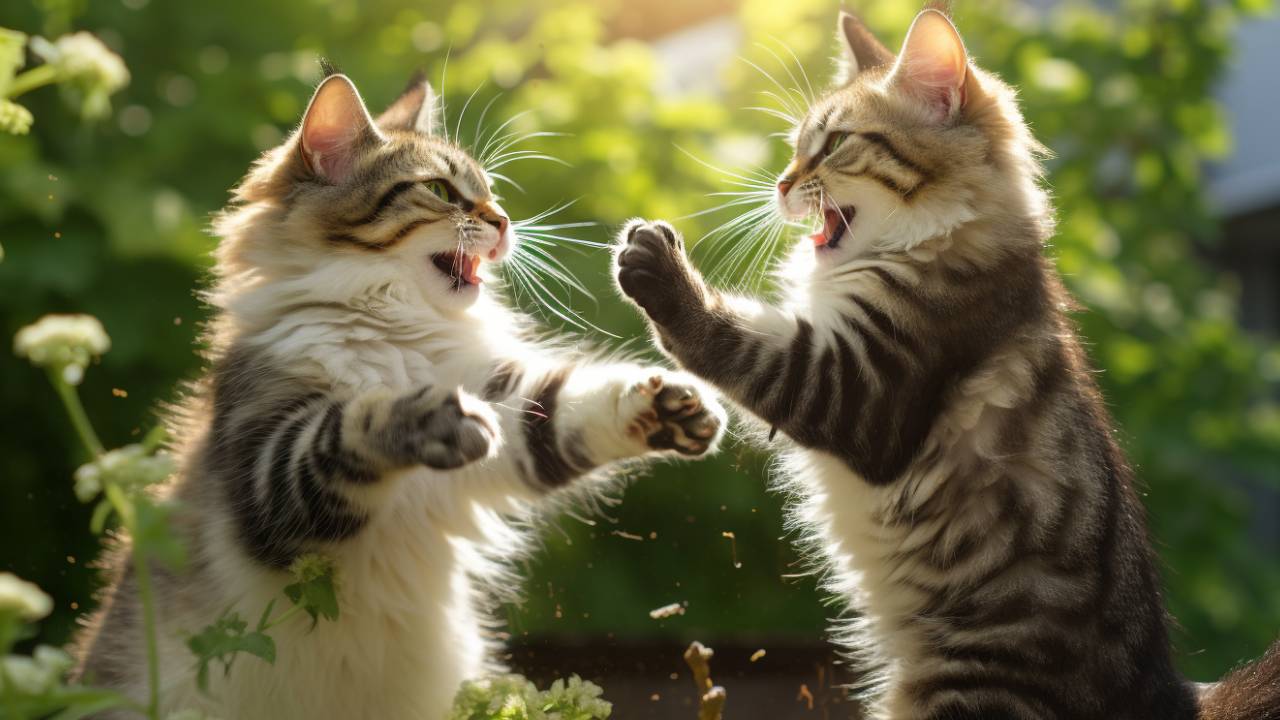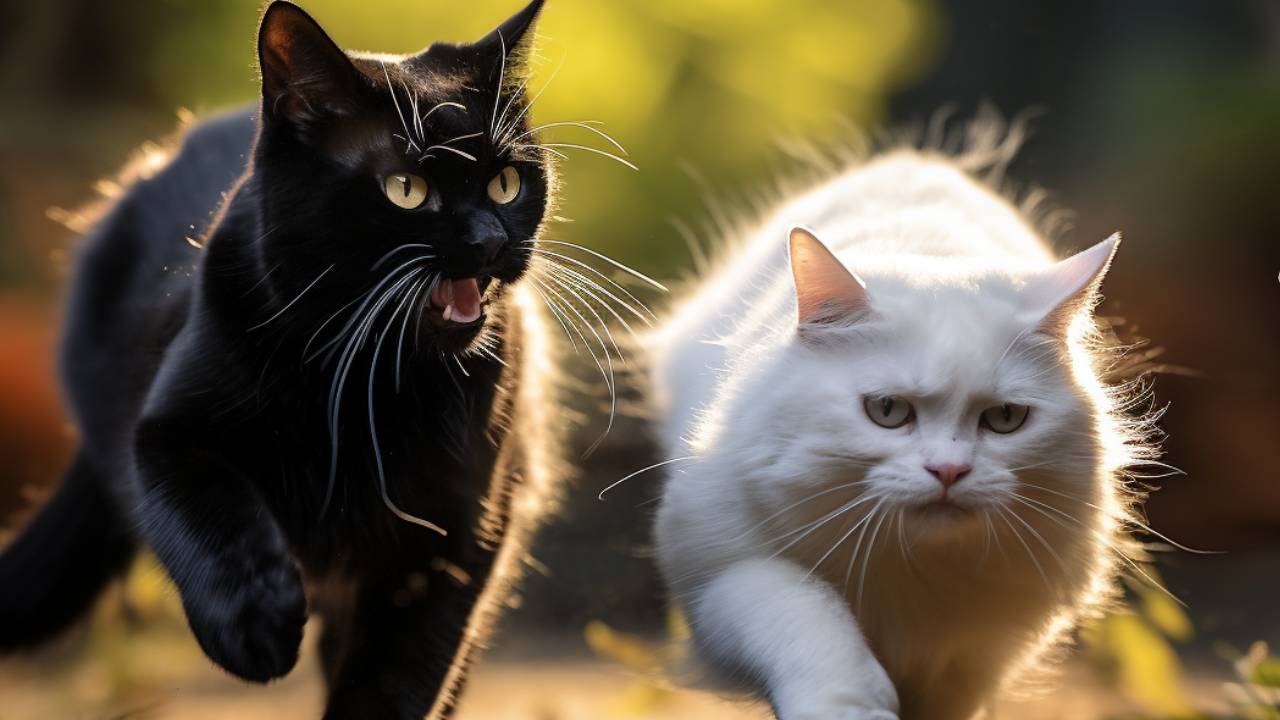You’re not alone if you’ve ever wondered why your cat dislikes other cats intensely. This article will demystify the intriguing world of cat territorial behavior, focusing on cats’ dislike of new cats.
Before we delve into the specific causes of cat aggression towards other cats and changing cat behavior towards other cats, we must recognize that there is no one-size-fits-all answer.
Each cat is unique, and aggressive behavior is influenced by a combination of factors, including genetics, early life experiences, and their current environment.
Causes of Cat Aggression Towards Other Cats
Cats are complex creatures, and when they exhibit aggression towards their fellow feline companions, it can be challenging to pinpoint the exact cause.
However, there are common triggers for cat aggression that can help us better understand their behavior and work towards fostering a more peaceful coexistence among our cats.
1. Territorial Instincts
Cats are naturally territorial, and conflicts often arise when they perceive an intrusion into their space. This territorial aggression can manifest in various ways.
Signs of Territorial Aggression:
- Urine Spraying: Cats may mark their territory by spraying urine on vertical surfaces. This serves as a clear “no entry” sign for other felines.
- Physical Confrontations: Cats may engage in physical fights, ranging from mild scuffles to aggressive encounters involving hissing, growling, and biting.
- Guarding Resources: Cats may become possessive of essential resources, such as food dishes, water bowls, or litter boxes, and aggressively guard them from other cats.
Solutions for Managing Territorial Behavior:
- Spacious Living Environment: Providing ample space for each cat can help reduce territorial conflicts. Cats need their territories, and having separate areas with resources can ease tensions.
- Neutering/Spaying: This can reduce territorial behavior, particularly in male cats.
- Behavior Modification: Working with a professional animal behaviorist can help modify aggressive behaviors by employing positive reinforcement techniques.
- Gradual Introductions: When introducing a new cat to the household, do so gradually. Keep the new cat in a separate space initially and allow the cats to get accustomed to each other’s scent before a face-to-face meeting.
2. Fear and Anxiety
Fear-induced aggression can occur when a cat feels threatened or anxious. It is essential to identify the source of your cat’s fear and take steps to alleviate it.
Recognizing Fear-Induced Aggression:
- Hiding: Fearful cats might hide and only emerge when they feel safe.
- Hissing and Growling: When cornered or overwhelmed, a cat might use hissing or growling as a defense mechanism.
- Defensive Posture: The cat may adopt a defensive body posture with an arched back, puffed fur, and dilated pupils.
Easing Your Cat’s Anxieties:
- Positive Associations: Use treats and play to create positive associations with previously feared situations.
- Pheromone Diffusers: Feliway diffusers, which release calming pheromones, can help reduce anxiety.
- Consulting a Professional: In cases of severe anxiety or aggression, a veterinary behaviorist can provide guidance and potentially prescribe medications to alleviate fear.
3. Lack of Socialization
Socialization is a critical aspect of a cat’s early development. Kittens who haven’t been adequately socialized during their formative weeks may struggle to adapt to the company of other cats.
Identifying Socialization Issues:
- Avoidance: The cat actively avoids interactions with other cats.
- Hiding: They may hide when other cats are around.
- Aggression Out of Fear: In extreme cases, lack of socialization can lead to fear-related aggression.
Tips for Socializing Your Cat:
- Early Socialization: Ideally, kittens should be socialized between 3 to 9 weeks of age. Positive interactions with other cats during this time can shape their behavior.
- Slow and Controlled Introductions: When introducing an unsocialized cat to others, do so gradually and under supervision. Use positive reinforcement and treats to reward calm behavior.

4. Resource Competition
Cats can become possessive of essential resources like food, water, litter boxes, or even your attention. When they perceive a shortage of these resources, it can lead to aggression.
Detecting Resource-Related Aggression:
- Guarding Food or Water: A cat might become overly possessive of its food or water, guarding the dishes and preventing other cats from accessing them.
- Blocking Access to Litter Boxes: Some cats may assert dominance by blocking access to litter boxes or ambushing other cats using them.
- Chasing or Attacking Around Resources: Aggressive chases or attacks may occur around key resources, such as food dishes.
Managing Resources Peacefully:
To prevent or address resource competition, consider these strategies:
- Multiple Resources: To minimize competition, ensure multiple feeding stations, water bowls, and litter boxes.
- Feeding Separately: If one cat is food-aggressive, consider feeding them separately in a closed room.
- Scheduled Feedings: Implement scheduled instead of free feeding to reduce food-related conflicts.
- Interactive Feeders: Use puzzles or interactive toys to make mealtime more engaging.
5. Health Problems
Health problems can be a surprising cause of aggression in cats. When a cat is in pain or discomfort, it may lash out defensively or aggressively. Ruling out medical causes of aggression through a veterinary examination is crucial.
Signs That Health Issues Trigger Aggression:
- Irritability: A calm cat might become irritable, especially when touched or approached.
- Vocalization: Excessive meowing or crying could be a sign of distress.
- Sensitivity: The cat might be sensitive around a particular body area, leading to aggression when touched there.
Seeking Veterinary Help:
If you suspect your cat’s aggression is health-related, consult a veterinarian. They can perform a thorough examination and recommend appropriate treatment. Health problems can range from dental issues to arthritis, and addressing these concerns can alleviate aggressive behavior.
6. Past Trauma
Understanding aggression stemming from past trauma is essential to provide your cat with the care and support they need. Cats that have experienced past trauma, whether through neglect, abuse, or accidents, may be more prone to displaying aggression as a defense mechanism.
Understanding Aggression from Past Trauma:
- Fearful Aggression: Cats might lash out when they feel threatened or frightened.
- Avoidance: They may avoid interactions with humans or other animals.
- Trigger-Related Aggression: Specific triggers may provoke aggressive responses.
To help cats with past trauma, consider the following:
- Patience: Be patient with their progress, as it might take time for them to build trust.
- Positive Associations: Use treats and gentle interactions to create positive associations with people and other pets.
- Professional Help: In severe cases, consult with a professional animal behaviorist to develop a tailored plan for rehabilitation.

Real-Life Stories of Feline Aggression Triumphs
Learning from real-life experiences can provide valuable insights into how cats can overcome aggressive tendencies. These stories offer hope and inspiration to cat owners facing similar challenges, demonstrating that change is possible.
Oliver’s Journey to Peace
Oliver, a once-feisty tabby, had a history of territorial aggression. He would pick fights with other cats in the household and even exhibited aggressive behavior towards humans when he felt cornered. His owner, Sarah, decided to take action.
Sarah implemented a gradual reintroduction process for Oliver and the other cats, using scent swapping and controlled interactions. Over time, Oliver’s aggression decreased as he felt less threatened. Today, he peacefully coexists with other feline companions and enjoys a calm, contented life.
Conclusion
Understanding the root causes of cat aggression is the first step toward addressing these issues effectively. Socializing cats and providing a supportive environment are fundamental in preventing and managing aggression.
Every cat is unique, and what works for one may not work for another. Consistency and love are your most potent tools in nurturing a peaceful and loving feline environment.

FAQs
How do I get my cat to like another cat?
To help your cat like another cat, start with a gradual introduction. Keep the new cat in a separate room, allowing both cats to become accustomed to each other’s scent. Swap bedding or toys between them to familiarize them with each other’s presence.
How do you fix a jealous cat?
Ensure each cat has food, water, a litter box, and personal space. Offer individualized affection and playtime to prevent competition. Create positive associations by rewarding calm behavior when both cats are together.
Should I let my cats hiss at each other?
Allowing cats to hiss initially is acceptable if it doesn’t escalate to physical aggression. While it may be unsettling to witness, hissing is a natural feline behavior, often used to communicate discomfort or establish boundaries.
How long can it take for a cat to get used to another cat?
The time it takes for a cat to get used to another cat varies depending on the individuals involved. While some cats may adapt within a few weeks, others might take several months.
How do you discipline a cat for attacking?
Disciplining a cat for attacking should focus on redirecting their behavior rather than punitive measures. Avoid physical punishment, as it can worsen aggression. Use a firm “no” or a hiss to startle them. Then, redirect their attention to an appropriate toy or activity.






thats interesting
just like their owner 😂